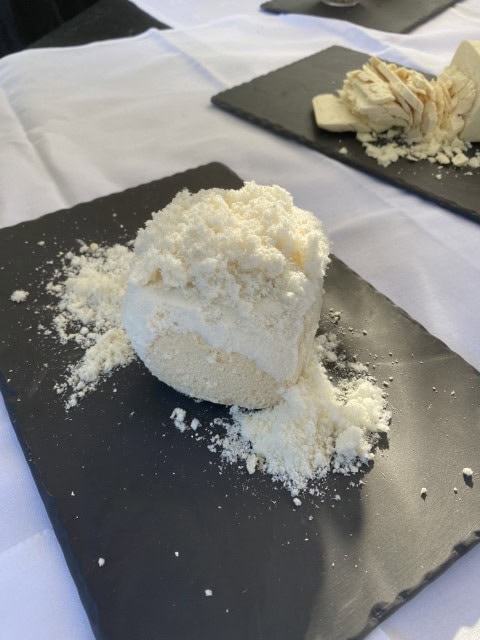By Gerhardus Geldenhuis
I grew up with salt that came in plastic bags and never really thought too much of it.
My grandfather and grandmother liked to fish at the festival grounds in Paris. The catfish were cut into fillets and tossed with very coarse salt to draw out the mud and make it edible.
Perhaps age has smoothed the rough edges of my memories, but I remember the fish cakes that my grandmother fried in the caravan’s tent with the catfish as delicious.
Today I will definitely be a little more hesitant about eating catfish and definitely more hesitant due to the deplorable state of the river water.
The treatment of the fish was my first introduction to salt as something more than just a spice that takes away the silly taste of food.
Funnily enough, I prefer fresh tomatoes without salt, but with most other food I prefer a little salt, even a pinch of salt in the fudge I make.
Salt also plays a cardinal role in history. Many towns in Europe arose because salt was mined and places like Venice’s trade was strongly driven by the salt trade.
The average adult has 250 g of salt in their bodies and the Egyptians used salt to preserve bodies. We cannot live without salt and will die if we do not get any of it.
However, this is not an excuse to suddenly add extra salt to your food, there is already a lot of natural salt in meat and too much salt is not good for you either. We do become less sensitive to tasting salt as we get older, so that might explain why my dad put salt in his coffee.
Without salt we don’t have edible olives or cheese. Of the traditional cheeses, Emmental has the least salt, around 0.7% and Roquefort and Pecorino up to 5%. Miso and soy sauce both have a large amount of salt components in them with miso containing between 6% and 12% salt depending on the type of miso you make. The English word for salad “salad” originally means “to salt”.
About a few years ago I went wine tasting with friends in the Cape and at that stage I read in a wine book of mine about the Romans who added salt to their wine. The purpose was twofold, for taste and to help with preservation because they didn’t have corks then.
To their horror, I added a pinch of salt to my wine and it was almost like they unfriended me for the assault on their senses. I can now testify that the specific experiment was not really successful but I want to try it again, this time with a salt water mixture to better control the amount of salt and maybe I can convince the friends this time.
Types of salt

There are basically two types of salt: salt made from seawater or salt that is mined from seawater long ago.
- Kosher salt: Salt in flake form, without iodine, which usually contains larger crystals. It is used to prepare kosher food.
- Sea salt: It is made from sea water that is evaporated and one of the best quality sea salt is Fleur de sel. It has the potential to taste different due to the crystal structure and how it dissolves salt but although it contains extra minerals, it contains so little that you are not realistically going to get enough of the minerals to make a significant difference.
- Table salt: Almost always contains iodine that is added for health reasons and a flow agent that helps the salt not crystallize and can come out easily. The flow agent is more difficult to dissolve in water than salt and may be partly responsible for making salt mixtures slightly cloudy.
- Pink salt: Comes from the Himalayas and contains small amounts of minerals that give it its characteristic color. It does not add a special taste and, like sea salt, has no health benefits, for the same reason. So use it just because it looks nice and not for health reasons.
Use of salt in food
So which salt should one use?
I personally use a high quality sea salt, which I buy 25 kg at a time, with no additives.
I always bought special cheese salt because it did not have iodine added but then later learned that the effect of iodine in salt to kill bacteria is not significant enough to make a difference in the bacteria that grows in the cheese.
I also have sea salt flakes that I use when I want a dish to have a particularly sharp salty taste. This salt works great with fudge or on focaccia. The use of salt is therefore more about the texture and about how quickly the salt dissolves.
Salt draws moisture out of food, so if you’re frying onions and want them to brown faster, you can add salt to help it along.
Meat that has been in contact with salt for longer will also taste more uniformly salty because the salt has had more chance to extract the moisture and soak into the meat.
When I bake bread I use salt as a percentage of the total weight. So if I have 1,000 g of ingredients, water included, then I add 1.5% salt which will then be 15 g but as much as 2% is still nice. I use the same method when making large quantities of food to add the right amount of salt, I start at 1.5% and then add as needed.

Salt also helps to take away bitter tastes, so if you read the column A salad with all five tastes “for my trembling toe” then you will understand why there is salt in a salad.
Miso and soy sauce are also forms of salt and extra flavor. The Turks have a by-product called Kurut or Keş which is drained yogurt mixed with salt. They form the mixtures into small balls which they then let dry until they become rock hard. The Keş is soaked in water and then the water is used as a base for stew, soup or other dishes. The remaining Keş is then dried again and stored for later use.
I’m making my own soy sauce and when it’s ready one day I’m going to share some recipes and simply explain how to make miso, because the two are different sides of the same coin.
If you ever find yourself in the Canary Islands, order the papas arrugadas. These are small potatoes that have been boiled in strongly salted water. The potatoes are served with a layer of salt still on and you think it’s going to be hopelessly too salty, but it’s delicious. It is served with “mojo”-sauce, a red and a green, so if you like your “mojo” lost you now know where to get new ones.
If you want to read more about the history of salt, read on Salt: A World History by Mark Kurlansky. As always, I’d love to hear about any salty experiences and stories.
- Gerhardus lives in England with his heart in South Africa. He regularly prepares large meals for the church, hosts cooking workshops at his home, such as how to make your own miso, and also picks more flowers and fruit every year than he can ever eat himself. So he regularly distributes jam, syrup and other tasty things to friends. He learned to bake bread in a German bakery and is actively involved in the Oxford Food Symposium on Food & Cookery. Send Gerhardus an e-mail (email protected).








